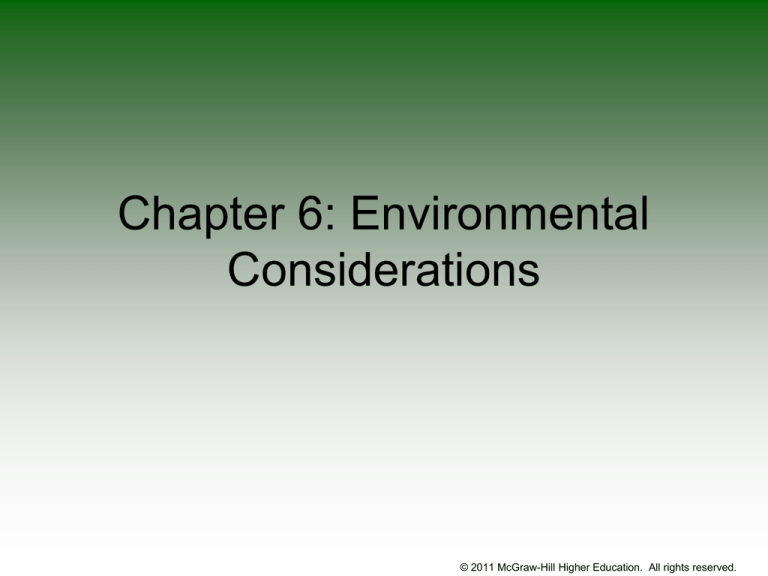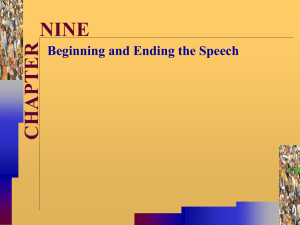
Chapter 6: Environmental
Considerations
© 2011 McGraw-Hill Higher Education. All rights reserved.
• Environmental stress can adversely
impact performance and pose serious
health threats
• Areas of concern
– Hyperthermia
– Hypothermia
– Altitude
– Exposure to the sun
– Lightning storms
– Air pollution
– Circadian dysrhythmia
© 2011 McGraw-Hill Higher Education. All rights reserved.
Hyperthermia
• Athletic trainers require knowledge and
information concerning temperature,
humidity and weather to adequately make
decisions regarding environmental
dangers
• Has caused a number of deaths over the
years
• Must manage heat stress appropriately
and plan accordingly with coaching staffs
© 2011 McGraw-Hill Higher Education. All rights reserved.
Heat Stress
• Extreme caution should be used when
training in the heat (overexposure could
result in heat illness)
• It is preventable
• Athletes that train under these extreme
conditions are at risk
• Physiologically the body will continue to
function if body temperature is maintained
• Body must be able to dissipate heat to
maintain homeostasis
© 2011 McGraw-Hill Higher Education. All rights reserved.
• The clinician must also consider that
young athletes and the elderly are more
susceptible to heat stress
• The ability to dissipate heat may be
limited due to the utilization of
equipment and certain clothing
• Heat stress can also be a factor when
competing in the cold if heat dissipation
is limited and dehydration occurs
© 2011 McGraw-Hill Higher Education. All rights reserved.
• Metabolic Heat Production
– Normal metabolic function results in
production of heat (will increase with
intensity of exercise)
• Conductive Heat Exchange
– Physical contact with objects resulting in
heat loss or gain
• Convective Heat Exchange
– Body heat can be lost or gained depending
on circulation of medium
• Radiant Heat Exchange
– Comes from sunshine and will cause
increase in temperature
© 2011 McGraw-Hill Higher Education. All rights reserved.
• Evaporative Heat Loss
– Sweat glands allow water transport to
surface
– Evaporation of water takes heat with it
– When radiant heat and environment
temperature are higher than body
temperature, loss of heat through
evaporation is key
– Lose 1 quart of water per hour for up to 2
hours
– Air must be relative water free for
evaporation to occur
• relative humidity of 65% impairs evaporation
• relative humidity of 75% stops evaporation
© 2011 McGraw-Hill Higher Education. All rights reserved.
Preventing Heat Illness
• Common sense and precaution
– Consume fluids and stay cool
– In conjunction with the NATA
recommendations, multiple factors should
be strongly considered
• Hydration
– Should begin activity well hydrated
• Involves hydrating during the 24 hours prior to
activity
• Urine should be a light yellow in color
• Dark urine is an indication of dehydration
© 2011 McGraw-Hill Higher Education. All rights reserved.
– Should consume fluid at regular intervals
• 17-20 fl oz of water or sports drink 2-3 hours prior to activity
and an additional 7-10 fl oz 10-20 minutes before exercise
• Dehydration
– Mild dehydration occurs when 2% of body weight is
lost in fluid
– Will impair cardiovascular and thermoregulatory
responses
– Signs & symptoms
• Thirst, dizziness, dry mouth, irritability, excessive
fatigue, and possible cramps
– Must move individual to cool environment and begin
rehydration
• Return to normal weight and absence of symptoms
© 2011 McGraw-Hill Higher Education. All rights reserved.
• Fluid and Electrolyte Replacement
– Body requires 2.5L of water daily when
engaged in minimal activity
– Adult will typically lose ~1.5L per hour
– 1-2% drop in body weight (due to
dehydration) results in thirst
– If thirst is ignored, dehydration results in:
• nausea, vomiting, fainting and increased risk
for heat illness
© 2011 McGraw-Hill Higher Education. All rights reserved.
– More likely to occur when exercising
outdoors sweating heavily and engaging in
strenuous exercise
– Prevent through hydration, don’t ignore
thirst, and don’t rely on it being your
indicator
– Generally only 50% of fluid is ever replaced
and should therefore be replaced before,
during and after exercise
– Athletes should have unlimited access to
water to prevent decrements in performance
and hypohydration
© 2011 McGraw-Hill Higher Education. All rights reserved.
• Using Sports Drinks
– More effective than just replacing fluids with water
– Flavoring results in increased desire to consume
– Replaces fluids and electrolytes
– Water alone can prematurely stop thirst response
and initiate fluid removal by kidneys
– Small amounts of sodium help in retention of
water
– Different drinks have different nutrient levels
– Optimal CHO level is 14g per 8 ounces of water
– More CHO results in slower absorption
– Effective for both short term and endurance
activities
© 2011 McGraw-Hill Higher Education. All rights reserved.
Figure 6-1
© 2011 McGraw-Hill Higher Education. All rights reserved.
• Gradual Acclimatization
– Most effective method of avoiding heat
stress
– Involves becoming accustomed to heat
and exercising in heat
– Early pre-season training and graded
intensity changes are recommended with
progressive exposure over 7-10 day period
– 80% of acclimatization can be achieved
during first 5-6 days with 2 hour morning
and afternoon practice sessions
– Equipment restrictions may help athlete
gradually acclimate
© 2011 McGraw-Hill Higher Education. All rights reserved.
• Identifying Susceptible Individuals
– Athletes with large muscle mass
– Overweight athletes (due to increased
metabolic rate)
– Death from heat stroke increase 4:1 as
body weight increases
– Women are physiologically more efficient
with regard body temp. regulation
– Others that are susceptible include, those
with poor fitness, history of heat illness, or
febrile condition, the young and the elderly
© 2011 McGraw-Hill Higher Education. All rights reserved.
• Uniform Selection
– Base on temperature and humidity
– Dress for the weather and temperature
– Avoid rubberized suits
• Weight Records
– Keep track of before and after measures
for first two weeks
– If increase in temperature and humidity
occurs during the season, weights should
again be recorded
– A >2% loss of BW could be a health threat
and should be removed from practice until
normal weight is achieved
© 2011 McGraw-Hill Higher Education. All rights reserved.
Monitoring Heat Index
• Heat, sunshine and humidity must be
monitored closely
• Wet bulb globe temperature index (WBGT)
provides objective measure for determining
precautions concerning participation in hot
– WGBT incorporates different thermometer
readings
• Dry bulb (standard mercury temperature)
• Wet bulb (thermometer with wet gauze that is swung
around in air)
• Black bulb (black casing that measures radiant heat)
• Formula yields WBGT index
© 2011 McGraw-Hill Higher Education. All rights reserved.
– DBT and WBT can be measured with
psychrometer (combines both
thermometers)
• Wet bulb will be lower due to evaporation of
water
• Drier air = greater depression of wet bulb
temperature due to evaporation
– Ventilation is provided by whirling
thermometer (sling psychrometer) or
suction fan (aspiration psychrometer)
– Newer models utilize digital sensors
© 2011 McGraw-Hill Higher Education. All rights reserved.
Figure 6-2
© 2011 McGraw-Hill Higher Education. All rights reserved.
Figure 6-3
© 2011 McGraw-Hill Higher Education. All rights reserved.
Heat Illnesses
• Heat rash (prickly heat)
– Benign condition associated with red,
raised rash, combined with prickling with
sweat
– Result of continuously wet un-evaporated
sweat
– Continually toweling the body will prevent
– Generally localized to areas covered with
clothing
© 2011 McGraw-Hill Higher Education. All rights reserved.
• Heat Syncope (heat collapse)
– Associated with rapid fatigue and overexposure,
standing in heat for long periods of time
– Caused by peripheral vasodilation, or pooling of
blood in extremities resulting in dizziness and
fainting
– Treat by placing athlete in cool environment,
consuming fluids and laying down
• Heat Cramps
– Painful muscle spasms (calf, abdominal) due to
excessive water loss and electrolyte imbalance
– Occurs in individual in good shape that overexert
themselves
© 2011 McGraw-Hill Higher Education. All rights reserved.
– Profuse sweating results in loss of water
and electrolytes (sodium, potassium,
magnesium, and calcium)
– Prevent by consuming extra fluids and
maintaining electrolyte balance
– Treat with fluid ingestion and light
stretching with ice massage
– Return to play unlikely due to continued
cramping
© 2011 McGraw-Hill Higher Education. All rights reserved.
• Exertional Heat Exhaustion
– Result of inadequate fluid replacement
– Unable to sustain adequate cardiac output
– Will exhibit signs of profuse sweating, pale
skin, mildly elevated temperature,
dizziness, nausea, vomiting or diarrhea,
hyperventilation, persistent muscle cramps,
and loss of coordination
– May develop heat cramps or become
faint/dizzy
– Core temperature will be <104o
– Performance may decrease
© 2011 McGraw-Hill Higher Education. All rights reserved.
– Immediate treatment includes fluid
ingestion (intravenous replacement,
ultimately), place in cool environment,
remove excess clothing
– Must continue to monitor vital signs
– Return to play – must be fully hydrated and
be cleared by a physician
– If not appropriately treated it could
progress to exertional heat stroke
© 2011 McGraw-Hill Higher Education. All rights reserved.
• Exertional Heatstroke
– Serious life-threatening condition, with
unknown specific cause
– Characterized by sudden onset - sudden
collapse, LOC, CNS dysfunction, flushed
hot skin, minimal sweating, shallow
breathing, strong rapid pulse, and core
temperature of > 104o F
– Breakdown of thermoregulatory
mechanism
© 2011 McGraw-Hill Higher Education. All rights reserved.
– Drastic measures must be taken to cool
athlete
•
•
•
•
•
Strip clothing
Sponge with cool water
Do not immerse in water
Transport to hospital immediately
Cool first, transport second
– Athlete should avoid exercise for a
minimum of one week and gradually return
to full practice
• Must be asymptomatic and cleared by
physician
– Death may result if not treated
appropriately
© 2011 McGraw-Hill Higher Education. All rights reserved.
• Malignant hyperthermia
– Muscle disorder causing hypersensitivity to
anesthesia and heat
– Similar S&S to heatstroke - muscle biopsy
is needed to detect
– Athlete will complain of muscle pain after
exercise
– Temperature will remain elevated 10-15
minutes following exercise
– Athlete with condition should be
disqualified from competition in hot, humid
environments
© 2011 McGraw-Hill Higher Education. All rights reserved.
• Acute Exertional Rhabdomyolysis
– Sudden catabolic destruction and
degeneration of skeletal muscle (myoglobin
and enzyme leakage into vascular system)
– Occurs during intense exercise in heat and
humidity resulting in:
• gradual muscle weakness, swelling, pain, dark
urine, renal dysfunction
• severe case = sudden collapse, renal failure and
death
– Associated with individuals that have sickle
cell trait
– Should be referred to a physician
immediately
© 2011 McGraw-Hill Higher Education. All rights reserved.
• Exertional Hyponatremia
– Fluid/electrolyte disorder resulting in
abnormally low concentration of sodium in
blood
– Caused by ingesting too much fluid before,
during and after exercise
– May be result of too little sodium in diet or
to much ingested fluids over a period of
prolonged exercise
– Athletes that ingest large quantities of
water and sweat over several hours are at
risk (marathon, triathlon)
– Preventable – must maintain balance
© 2011 McGraw-Hill Higher Education. All rights reserved.
– Signs and Symptoms
• Progressively worsening headache, nausea,
vomiting
• Swelling of hands and feet, lethargy, apathy or
agitation
• Low blood sodium
• Could compromise CNS and create a lifethreatening situation
– If levels can not be determined on-site,
measures to rehydrate should be delayed
and the athlete should be transported to a
medical facility
• Delivery of sodium, diuretics, or intravenous
solutions may be necessary
© 2011 McGraw-Hill Higher Education. All rights reserved.
Guidelines for Athletes Who
Intentionally Lose Weight
• Predispose themselves to heat related
injuries and could create life-threatening
situations
• Weight loss should not be accomplished
through dehydration
• Gradual process over weeks and months
and should be a result of body fat lost
• NCAA and high school federations have
established guidelines for weight loss in
wrestling
© 2011 McGraw-Hill Higher Education. All rights reserved.
Hypothermia
• Cold weather vs. nature of particular sport
• Most activity allows for adequate heat
production (increased metabolism) and
dissipation, allowing for sufficient
functioning
• Impact on warm-up and “down time”
• Temperature in conjunction with wind chill
and dampness or wetness can increase
chances of hypothermia
© 2011 McGraw-Hill Higher Education. All rights reserved.
• 65% of body heat is lost through radiation
(head and neck 50%)
• 20% through evaporation
• 2/3 through skin and 1/3 through
respiration
• Problems arise when heat lost exceeds
heat production generated by metabolism
– Results in impairment of neuromuscular
function
• Drop in core stimulates shivering but
stops after temp. drops below 85-90oF
• Death is imminent when temp falls below
77-85oF.
© 2011 McGraw-Hill Higher Education. All rights reserved.
Figure 6-4
© 2011 McGraw-Hill Higher Education. All rights reserved.
• Prevention
– Apparel geared for weather to provide
semitropical microclimate for body and prevent
chilling
– Waterproof and windproof fabrics that allow
passage of heat and sweat and allow movement
– Layers and adjusting them are key to
maintaining body temperature (during period of
(in)activity)
– Be aware of inadequate clothing, improper
warm-up and chill factor can lead to injury,
frostbite, chilblains, and/or minor respiratory
problems
– Be aware of hydration levels as well to enhance
blood volume and heat maintenance
© 2011 McGraw-Hill Higher Education. All rights reserved.
• Common Cold Injuries
– Localized cooling can result in tissue
damage
• Formation of ice crystals between cells,
destroys cells, disrupts blood flow, clotting may
occur
– Frost nip
• Involves, ears, nose, chin, fingers, and toes
• Occurs with high wind and/or severe cold
• Skin appears firm with cold painless areas that
may peel and blister (24-72 hours)
• Treat with firm pressure, blowing warm air or
hands in armpits (if fingers involved)
• Do not rub
© 2011 McGraw-Hill Higher Education. All rights reserved.
– Frostbite
• Chilblains result from prolonged exposure causing
redness and swelling, tingling pain in toes and
fingers
• Due to poor peripheral circulation
• Superficial Frostbite involves only skin and
subcutaneous tissue
• Appears pale, hard, cold and waxy
• When re-warming the area will feel numb, then
sting and burn
• It may blister and be painful for several weeks
• Deep Frostbite indicates frozen skin requiring
hospitalization
• Rapid re-warming is necessary (100-110oF)
• Tissue will become blotchy red, swollen, painful and
may become gangrenous
© 2011 McGraw-Hill Higher Education. All rights reserved.
Altitude
• Most events do not occur at extreme
heights
• As height increases, maximum oxygen
uptake decreases resulting in a
decrease in performance
• Body compensates through tachycardia
and hyperventilation
• Responses are a result of having fewer
red blood cells than necessary to
adequately capture available oxygen
© 2011 McGraw-Hill Higher Education. All rights reserved.
• Adaptations
– Increased height = reduced barometric
pressure resulting in decreased partial
pressure of oxygen = less saturation of red
blood cells
– Individual adaptations dependent on whether
the person is a native, resident or visitor
• Native has larger chest capacity, more alveoli,
capillaries and red blood cells
• Resident makes partial adaptations (increased
mitochondria and hemoglobin, glycogen
conservation)
• Visitor responds with increased breathing, heart
action, hemoglobin, blood alkalinity, myoglobin
and changes in blood flow and enzyme activity
© 2011 McGraw-Hill Higher Education. All rights reserved.
– Other uncertainties with regards to training
and competition
• Time to adjust (2-3 weeks vs. 3 days)
• Short adjustment allows acid-base balance to
recover but does not allow significant changes in
blood volume and maximum cardiac output
• Altitude Illnesses
– Acute Mountain Sickness
• 1 out of 3 will experience when making the jump
7000-8000 feet.
• Experience headache, nausea, vomiting, sleep
disturbance, and dyspnea
• Caused by brain disruption associated with
sodium potassium imbalance resulting in fluid
retention and cellular pressure changes
© 2011 McGraw-Hill Higher Education. All rights reserved.
– Altitude Pulmonary Edema
• Occurs at 9000-10,000 feet.
• Lungs accumulate fluid in alveolar walls forming
pulmonary edema
• Signs and symptoms: dyspnea, cough,
headache, weakness and occasionally
unconsciousness.
• Treat by moving athlete to lower altitude and
providing oxygen
© 2011 McGraw-Hill Higher Education. All rights reserved.
– High Altitude Cerebral Edema (HACE)
• Usually occurs in conjunction with other life
threatening conditions that can lead to coma or death
• Occurs in ~1% of people adjusting to altitudes above
9,000 feet
• Result of increased cerebral edema due to increased
cerebral blood flow, which is caused by increased
permeability of cerebral endothelium when exposed
to hypoxia
• The increased cerebral blood flow results in
increased intracranial pressure
• Signs & symptoms
– Severe, persistent headache which may precede
mental dysfunction, neurologic abnormalities
• Decent to lower altitudes may save those with
HACE
© 2011 McGraw-Hill Higher Education. All rights reserved.
– Sickle Cell Trait Reaction
• 8-10% of African Americans have sickle cell
trait
• In most the trait is benign
• Abnormality in red blood cell hemoglobin
structure
• When hemoglobin is deoxygenated, cells clump
together causing blood cell to develop sickle
shape making it easy to destroy
• Causes enlarged spleen and could rupture at
high altitudes
© 2011 McGraw-Hill Higher Education. All rights reserved.
Overexposure to Sun
• Precautions must be taken to protect
athletes, coaches, athletic trainers and
support staff
• Long Term Effects on Skin
– Premature aging and skin cancer due to
ultraviolet exposure
– Premature aging is characterized by
dryness, cracking and inelasticity of the
skin
– Skin cancer is the most common malignant
tumor found in humans
© 2011 McGraw-Hill Higher Education. All rights reserved.
– Damage to DNA is suspected as the cause
of cancer
– Major types include basal cell carcinoma,
squamous cell carcinoma and malignant
melanoma
– Rate of cure is 95% with early detection
– Fair skinned individuals are more
susceptible to these maladies
© 2011 McGraw-Hill Higher Education. All rights reserved.
• Using Sunscreen
– Can help prevent damaging effects of UV
radiation
– Sunscreen effectiveness is expressed as SPF
(sun protection factor)
• Indicates how many times longer an individual can
be exposed to the sun with vs. without sunscreen
before skin turns red.
• Greater the susceptibility the higher the SPF should
be used
– Should be worn by athletes, coaches and
athletic trainers who are outside a considerable
amount, and/or have fair complexion, light hair,
blue eyes or skin that burns easily
© 2011 McGraw-Hill Higher Education. All rights reserved.
– Individuals with dark complexion should
also apply
– 60-80% of sun exposure occurs before the
age of 20
– Sunscreen use is at its highest March November but should be used year round
(particularly between the hours of 10am4pm)
– It should be applied 15-30 minutes before
exposure and re-applied after exposure to
water, excess sweating, rubbing skin with
clothing or a towel
© 2011 McGraw-Hill Higher Education. All rights reserved.
Lightning Safety
• #2 cause of death by weather phenomena
• NATA has established position statement
due to number of athletes and coaches
potentially exposed to lightning scenarios
• Emergency action plans must be set for
this type of event
– Involving chain of command, monitoring of
weather service, decision making regarding
removal and return to field
© 2011 McGraw-Hill Higher Education. All rights reserved.
• In the event of a storm, shelter indoors
should be obtained
• Other guidelines
– Avoid large trees, flag/light poles, standing
water, telephones, pools, showers, and
metal objects (bleachers, equipment,
umbrellas)
– Last resorts find car, ravine, ditch or valley
for safety
– If hair stands up on hand you are in
imminent danger and should get down on
the ground but not flat as that increases
surface area
© 2011 McGraw-Hill Higher Education. All rights reserved.
• Additional Guidelines
– Lightning is generally accompanied by
thunder (except 20-40% of the time due to
atmospheric disturbances)
– Flash-to-bang methods estimates distance
away for the storm
• From time lightning is sighted to the clap of
thunder count, divide by 5 to calculate the
number of mile away
• Count of 30 indicates inherent danger
• Count of 15 seconds everyone should leave the
field
© 2011 McGraw-Hill Higher Education. All rights reserved.
– NATA and National Weather Service
recommend returning to the field 30
minutes following the last clap of thunder
or lightning strike
– Major misconception is that lightning that is
seen striking is coming down
• In actuality it is the return stroke of the lightning
going back up after it has already hit the ground
© 2011 McGraw-Hill Higher Education. All rights reserved.
• Lightning detector
– Hand-held instrument
– Able to detect storm
occurring within 40 miles
– Allows you to know level
of activity and direction
– When it detects a
lightning stroke it emits
an audible warning tone
– Inexpensive alternative to
setting up contract with
weather service
Figure 6-6
© 2011 McGraw-Hill Higher Education. All rights reserved.
Air Pollution
• Significant problem throughout the
United States
• Two types
– Photochemical haze: nitrogen dioxide and
stagnant air acted on by sunlight to
produce ozone
– Smog: combination of carbon monoxide,
sulfur dioxide, and particulate matter
© 2011 McGraw-Hill Higher Education. All rights reserved.
• Ozone
• Formed by the action of sunlight on carbon
based chemicals (hydrocarbons) in
combination with nitrogen dioxides
– Minimum activity levels - ozone will not impact
– Higher intensity will have a negative effect on
work output
– May experience shortness of breath,
coughing, chest tightness, pain with deep
breathing, nausea, eye irritation, fatigue, lung
irritation, lowered resistance to lung infection
– Asthmatics are at greater risk
– May become desensitized over time
© 2011 McGraw-Hill Higher Education. All rights reserved.
• Sulfur Dioxide
– Colorless gas that is a component of
burning coal or petroleum
– Causes increased resistance to air
movement in and out of the lungs,
decreased ability of lungs to rid themselves
of foreign matter, shortness of breath,
coughing, fatigue and increased
susceptibility to lung diseases
– Adverse effects mostly on asthmatics
– Nose breathing lessens the effects due to
filtering of nasal mucosa
© 2011 McGraw-Hill Higher Education. All rights reserved.
• Nitrogen Dioxide
– Produced through combustion
(automobiles, power plants, home heaters
and gas stoves)
– Factor in atmospheric reaction to generate
ozone and acid rain
– Can irritate the lungs, lower resistance to
respiratory infection and may increase
incidence of respiratory disease in children
© 2011 McGraw-Hill Higher Education. All rights reserved.
• Carbon Monoxide
– Colorless, odorless gas.
– Reduces hemoglobin’s ability to transport
oxygen and restricts release of oxygen to
the tissue
– Interferes with performance, and various
psychomotor, behavioral, and attentionrelated activities
© 2011 McGraw-Hill Higher Education. All rights reserved.
• Particulate Matter
– Solids found in atmosphere (dust, pollen,
molds, ashes, soot, aerosol)
– Generated through wood burning, factory
smokestacks, mining construction
– Small enough to be inhaled and absorbed
into the bloodstream or remain imbedded
– Exposure to this matter may trigger asthma
attacks, cause whizzing or coughing,
respiratory irritation in people with chronic
obstructive pulmonary lung disease
(COPD) including emphysema and
bronchitis
© 2011 McGraw-Hill Higher Education. All rights reserved.
• Prevention
– To avoid problems, stop or decrease
activity during periods of high pollution
– Perform when commuter traffic is less and
ambient temperature is lower
– Avoid high times relative to ozone levels
– Running should be avoided in areas of
high traffic due to auto emissions and
carbon monoxide
© 2011 McGraw-Hill Higher Education. All rights reserved.
Circadian Dysrhythmia (Jet Lag)
• Desynchronization of biological and
biophysical time clock
• Body maintains cyclical mechanisms
over 24 hour periods (circadian rhythms)
• Body adapts over time to changes
– Immediately (protein metabolism)
– Over 8 days (body temperature)
– Three weeks (adrenal hormones)
© 2011 McGraw-Hill Higher Education. All rights reserved.
• Jet lag refers to physical and mental
effects caused by traveling rapidly across
time zones
– Disrupts circadian rhythms and sleep-wake
cycles
• May cause fatigue, headaches, digestive disorder,
changes in blood pressure, heart rate, hormone
and endocrine releases, and bowel habits
• Could negatively impact performance and
predispose athlete to injury
• May become ill, suffer short term anorexia,
headaches, blurred vision, dizziness, insomnia
and/or fatigue
– Younger individuals adjust more rapidly
• 30-50% faster adaptation flying westward
© 2011 McGraw-Hill Higher Education. All rights reserved.
• North-south travel has no impact unless time
zones are crossed
• Changes in zones, illumination and
environment can be disruptive (>5 time zones)
– To prevent
• Depart well rested
• Pre-adjust
– Eat according to time changes
– Avoid dehydration
– Training schedule
• Use caffeine when travelling west
• Adopt local time on arrival
• Avoid alcohol, before, during and after the trip
© 2011 McGraw-Hill Higher Education. All rights reserved.
Synthetic Turf
• Believed to be:
– durable, offer great consistency, usable with
inclement weather, require less maintenance
– offer greater performance in areas of speed
and resiliency
• Variety of surfaces have been created
since 1960’s
• Most recent is “resilient infill turf”
– Similar to grass, polyethylene and
polypropylene yarn on a base of sand, rubber
pellets or combination
© 2011 McGraw-Hill Higher Education. All rights reserved.
• Constant debate
– Injury perspective- not conclusive evidence
that synthetic surface increases injury rates
– Empirically, athletes, coaches, and athletic
trainers agree that injuries are more likely on
turf
• Most would prefer to play and practice on natural
surfaces
• Hybrid, more durable grasses are also available
– Synthetic surfaces
• Lose shock absorbing capabilities
• Injuries are more likely to occur when training
always occurs on turf
© 2011 McGraw-Hill Higher Education. All rights reserved.
• Due to possibly of higher speeds obtained on
turf, injuries involving collisions could be more
severe due to increased force and impact
– Shoes that don’t “stick” will significantly
reduce likelihood of injury
– Common injuries
• Abrasions (reduce with padding)
• Turf toe (less likely to occur if shoes has stiff,
firm sole)
© 2011 McGraw-Hill Higher Education. All rights reserved.









